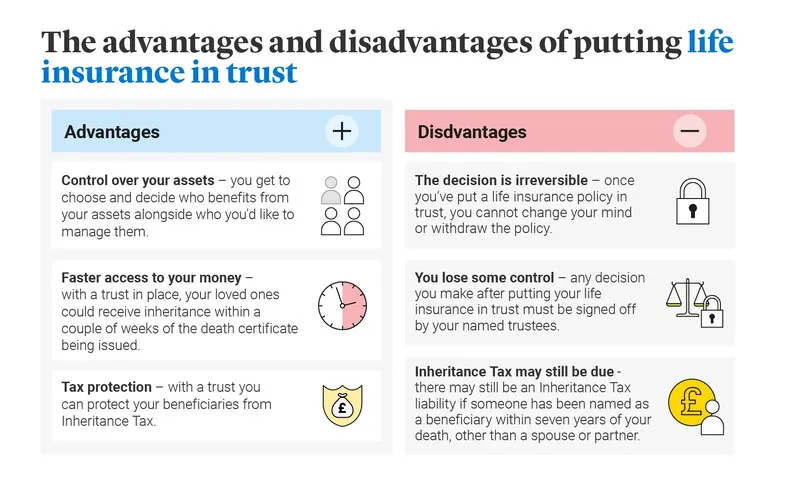Setting Up Life Insurance Trust – How to Secure All Your Children’s Future Today
Establishing a life insurance trust can be a strategic approach to ensuring your children’s financial stability in the future. Life insurance trusts have the potential to protect wealth, ensure that inheritance is handled wisely, and offer tax advantages. This article explores the fundamental aspects of life insurance trusts, the steps to form one, and their key benefits in estate planning.
What is a Life Insurance Trust?
A life insurance trust is a legal entity that owns and manages a life insurance policy for the benefit of specified individuals, such as children. By transferring ownership of your life insurance policy to a trust, it is no longer part of your personal estate, which can significantly reduce estate taxes.

This arrangement provides security for funds intended for children without imposing an additional tax burden on them. Life insurance trusts offer flexibility in how and when your children receive money, providing a reliable framework for managing significant assets.
- Important Timing : Establish the trust well before the policyholder’s death to maximize tax benefits.
- Fund Control : The trust allows you to decide how funds are distributed, reducing the risk of misuse.
Why Consider a Life Insurance Trust for Your Children?
The primary purpose of setting up a life insurance trust is to secure your children’s financial stability, protect assets, and decrease tax liabilities. A trust offers an organized method for the distribution of life insurance funds according to your wishes.
Moreover, it can prevent potential misuse of money by beneficiaries who may lack experience or understanding in managing finances. For blended families or multiple beneficiaries, a trust provides a clear legal structure for inheritance allocation.
- Asset Protection : The trust can shield funds from creditors, enhancing long-term security for your children.
- Specific Needs : Customize disbursement terms to address unique requirements, such as education or medical expenses.
Steps to Set Up a Life Insurance Trust
Seek advice from an Estate Planning Lawyer. To ensure the trust meets legal standards and your family’s needs, work with a qualified estate planning lawyer. This professional can help you understand legal implications and recommend the most suitable type of trust based on your financial circumstances and goals.
Next, establish the rules of the Trust. Specify these rules, including who will serve as trustee and when your children will receive their funds from it. Conditions can include limits such as granting access only after reaching a certain age or using funds for specific purposes like education or medical expenses. These conditions provide both an organized framework and flexibility, helping to safeguard assets for your children’s future.
Selecting a trustee is crucial. The choice of trustee is vital for proper trust management. The trustee can be a trustworthy family member, a professional individual, or an institution. Their responsibility is to oversee how funds are managed and distributed according to your instructions. In long- term situations, selecting a dependable trustee ensures your money is handled as desired.
The next step involves transferring life insurance policies to the Trust. Once the trust is established, fund it by changing the owner of your life insurance policy. This legal separation from your estate grants ownership and control to the trust. The trust becomes the beneficiary, ensuring that life insurance funds are directed to assist with children’s expenses without probate delays.
Finally, maintain the trust over time. Life changes, such as additional children, marital status changes, or financial condition shifts, may necessitate trust updates. Regularly reviewing the trust ensures it aligns with your goals, making necessary modifications as needed. Collaborating with your lawyer or financial advisor can help maintain the trust in line with your objectives.
- Regular Reviews : Update the trust periodically to reflect any family or financial changes.
- Trustee Choice : Selecting a financially savvy and reliable trustee is crucial for trust integrity.

Tax Implications and Benefits
A life insurance trust offers significant tax advantages. When the policy is owned by the trust rather than you, it is not subject to estate tax, effectively reducing the taxable portion of your estate.
A well-planned life insurance trust also protects assets from creditors, further enhancing financial security. However, to benefit from these tax advantages, the trust must be established and adequately funded, typically at least three years before the policyholder’s death.
- Three-Year Rule : Ensure the trust is established at least three years before death to maximize tax exclusions.
- Creditor Protection : Assets within the trust are generally safe from creditors, enhancing security.
Conclusion
Creating a life insurance trust requires careful planning but provides a reliable framework for securing your children’s financial future. By taking each step thoughtfully and consulting with experts, you can make informed decisions for your children’s well-being.


